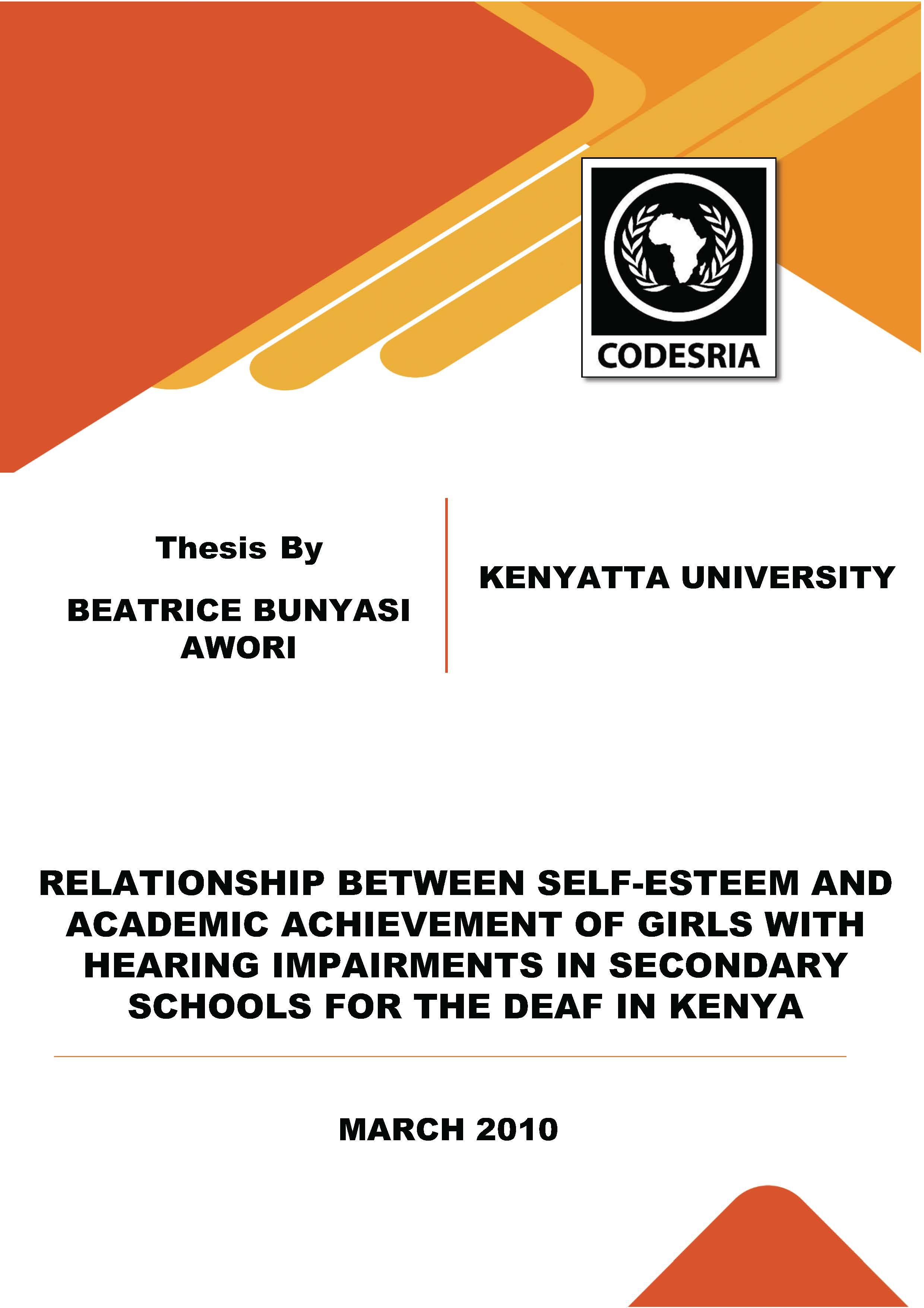Relationship between Self-Esteem and Academic Achievement of Girls with Hearing Impairments in Secondary Schools for the Deaf in Kenya
Keywords:
Disabled students, secondary schools, self-esteem, academic achievement, hearing impairment, Kenya, deafness, girlsSynopsis
The problem addressed in this study was that although several factors such as school environment, family status and/or communication barriers had been cited as contributing to the perpetually dismal academic achievement of girls with hearing impairments, personal esteem factors, especially interest, competence, value and responsibility had not been adequately explored. Consequently, their achievement had been low and continued to be low despite the government’s effort to increase educational opportunities for all its citizens through legislative and policy frameworks. The researcher postulated one null hypothesis Ho: There is no significant difference between self-esteem and academic achievement of girls with hearing impairment. The study was guided by Carl Roger’s personcentered or client-centered theory. The theory states that factors, which predicted later behaviour in human beings were self-understanding. The study used an Expost facto design. Rosenberg self-esteem scale was used to measure self-esteem dimensions whereas school academic scores were used to measure academic achievement. Participants for the study were drawn from schools for girls with hearing impairment in Central and Western provinces of Kenya constituting a sample of fifty-three girls. Data were collected through the use of questionnaires
and interviews and analyzed using the Statistical Package for Social Sciences programme. The results obtained indicated that girls with hearing impairments possessed high self-esteem yet their academic achievement was low. The correlation between self-esteem and academic achievement on Pearson Product Moment Correlation was at a moderate level. It was concluded that girls withhearing impairments placed more value on relational aspects (grooming), music and dance. They lagged behind in terms of provision of quality education due to lack of specialized technological devices. The study recommended that teachers
should make deliberate use of positive reinforcement that would encourage girls’ participation and promote their self-esteem towards academic performance. Principals of schools should initiate active collaborations with parents, teachers, students and other interested partners in developing constructive projects. The government to make curriculum to be flexible as the current curriculum was quite wide, rigid, examination oriented, had fixed timeframe and totally lacked diversity. Another recommendation was for the curriculum developers to reconsider curricula adaptation to allow diversity. The examining body to focus on practical assessment through strategies like observations, demonstrations and/or use of sign language interpreters for all required examinations. Provision of assistive devices is a necessity. The government should increase disability fund
to cater for girls’ exceptional needs as a very vulnerable group of learners and provide opportunities for capacity building for assistive devices technicians. Further intensive research to investigate the crucial emerging issues that contributed to the moderate correlation which occurred yet the academic achievement was low and self-esteem was high. Another recommendation is further research in the area of communication proficiency in Kenya Sign Language for all teachers in schools that admit learners with hearing impairment.
Downloads
References
APA, (2006). Publication manual of the American Psychological Association. Washington DC: American Psychological Association.
Ardail, R. H. (2005). Self-esteem and academic achievement in African American Students with learning disabilities. A Masters Degree Research Project. College of William and Mary, Williamburg. VA
Bandura, A. (1997). Self-efficacy: The exercise of control. New York: Freeman Bandura, A. (1986). Social foundations of thought and action. Englewood Cliff, NJ: Prentice Hall.
Baumeister, R. F. (1991). Meaning of life. NY: The Guilford Press.
Branden, N. (1969). The psychology of self-esteem: A revolutionary approach to self- understanding. Jossey-Bass, NY: Willey. Brown, J. D. (1998). The Self. NY: McGraw-Hill.
Byrne, B. (1990), Self-concept and academic achievement investigating their importance as discriminators of academic track membership in high school. Canadian Journal of Education, 15, 173-82.
Cloninger, S. (2004). Theories of personality: Understanding persons. NJ: Pearson Prentice Hall.
Covington, M. (1989). Self-esteem and failure in school; The social importance of self- esteem. Berkley, CA: U. C Press.
Davis, W. L. & Phares, E. J. (1967). Internal-external control as a determinant of information seeking in social influence situation. Journal of Personality, 34, 547- 561.
De Brabander, B. & Boone, C. (1990). Sex difference in perceived locus of control. Journal of Social Psychology, 130, 271-272.
De Mann, A.; Leduc C. & Labreche-Gauthier, L. (1992). Parental control in child rearing and multidimensional locus of control. Psychology Reports, 70, 320-322.
Desselle, D. (1992). Self-esteem, Family climate and communication patterns in relation to deafness. A doctoral Dissertation, University of New Orleans. Dissertation Abstracts International, 53, 27634 University Microfilms No. 92-30595.






